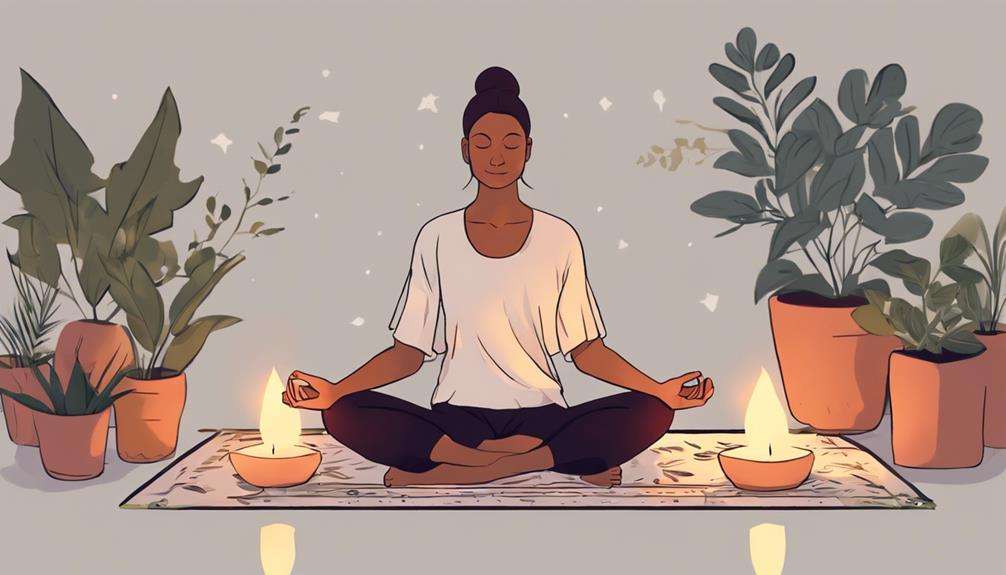Imagine finding a way to navigate life's ups and downs with a sense of calm and clarity. The practice of yoga and meditation holds the key to unlocking emotional balance in your everyday existence.
By tapping into the power of these ancient disciplines, you can discover a path towards inner peace and emotional stability. But how exactly do these practices work their magic on your mind and emotions?
Let's explore the transformative benefits that yoga and meditation offer for your emotional well-being.
Key Takeaways
- Enhance emotional regulation through yoga and meditation practices.
- Cultivate resilience and reduce reactivity with self-awareness.
- Develop emotional stability through breathwork and mindfulness.
- Nurturing daily meditation fosters inner peace and emotional balance.
Understanding Emotional Regulation in Yoga
In the practice of yoga, you can enhance your emotional regulation by developing self-awareness of your emotions and effectively managing them. Through meditation and mindfulness techniques within yoga, you can learn to recognize emotional triggers and respond to them with a sense of calm and clarity. This process allows you to cultivate emotional resilience, reducing reactivity to challenging situations that may arise in your life.
Yoga encourages self-reflection, providing you with the opportunity to explore your emotions and thought patterns more deeply. By practicing self-compassion and acceptance, you can create a foundation for emotional balance and well-being. Regular yoga sessions can lead to improved emotional regulation, resulting in greater inner peace and stability in your daily experiences.
The Role of Asanas in Emotional Balance
When practicing yoga asanas, you engage both your body and mind, creating a harmonious balance that can positively impact your emotional well-being.
As you flow through different poses, you release physical tension stored in your muscles, leading to a sense of emotional release and relaxation.
This physical release often translates into a calmer, more balanced state of mind, allowing you to navigate your emotions with greater ease and clarity.
Asana Benefits for Emotions
To cultivate emotional balance through yoga practice, exploring the benefits of various asanas is essential. Yoga asanas play a crucial role in promoting emotional well-being by releasing stored tension and stress, aiding in achieving inner calm and equilibrium.
Poses like backbends and chest openers can uplift your mood and boost feelings of positivity. On the other hand, forward folds and inversions help calm the mind, reduce anxiety, and enhance emotional stability.
Balancing poses challenge your focus and concentration, contributing to mental clarity and emotional regulation. By incorporating these diverse yoga poses into your practice, you can enhance self-awareness, find inner peace, and cultivate a sense of emotional balance in your life.
Asanas for Inner Peace
Exploring the various yoga asanas that promote inner peace is essential for enhancing emotional balance and well-being. Practicing specific yoga postures can help you reduce stress, calm the mind, and cultivate a sense of calm.
Here are five key ways yoga asanas contribute to inner peace:
- Asanas like child's pose and corpse pose release tension and promote relaxation for emotional balance.
- Warrior pose and tree pose increase self-awareness and inner peace through regular practice.
- Downward dog and bridge pose aid in reducing stress hormones and calming the mind for emotional stability.
- Balancing poses such as tree pose and eagle pose develop focus and concentration, fostering emotional equilibrium.
- Gentle flow sequences like sun salutations and moon salutations create a sense of calmness and emotional well-being.
Harnessing Breathwork for Emotional Stability

By incorporating specific breathing techniques in your yoga and meditation practice, you can effectively harness breathwork to enhance emotional stability and mental clarity.
Breathwork, such as deep breathing, activates the parasympathetic nervous system, facilitating relaxation and reducing stress hormones like cortisol. Engaging in mindful breathing practices can help regulate your emotions, calm your mind, and foster a sense of inner peace and balance.
Through controlled breathing techniques, you have the opportunity to improve emotional resilience, lessen anxiety, and promote overall well-being. Consistent practice of breathwork in yoga and meditation can lead to enhanced emotional self-regulation and increased emotional intelligence.
Cultivating Mindfulness for Emotional Well-being
When you engage in mindful breathing techniques and emotional awareness exercises during yoga and meditation,
you're fostering a deeper connection to your emotions and thoughts.
By practicing mindfulness, you can observe your emotional landscape without getting entangled in negative feelings,
leading to a greater sense of calm and balance.
These techniques are powerful tools to cultivate emotional well-being and enhance your overall quality of life.
Mindful Breathing Techniques
Mastering mindful breathing techniques is a powerful tool for cultivating emotional well-being through enhanced self-awareness and inner peace. Utilizing diaphragmatic breathing can help regulate emotions by calming the nervous system, while focused breathing activates the parasympathetic nervous system, reducing stress hormones and promoting emotional well-being.
These practices not only enhance emotional resilience but also foster a sense of inner peace by improving self-awareness. Techniques like box breathing can aid in managing emotions, reducing anxiety, and promoting emotional balance.
Regular practice of mindful breathing allows individuals to cultivate mindfulness, leading to better emotional regulation and overall well-being.
Emotional Awareness Exercises
Transitioning from mastering mindful breathing techniques, emotional awareness exercises in yoga and meditation play a pivotal role in cultivating mindfulness for emotional well-being. These practices involve observing emotions without judgment, allowing you to develop a deeper connection with your feelings.
By honing emotional awareness, you can enhance your emotional regulation and respond to situations in a more balanced way. Engaging in mindfulness practices for emotional well-being through yoga and meditation can help reduce reactivity and boost emotional resilience.
Cultivating emotional awareness not only fosters inner peace and self-compassion but also improves your relationships with others. Embrace these exercises to nurture a more mindful approach to your emotions and experience the benefits of a balanced emotional state.
Exploring the Connection Between Yoga and Emotions

Exploring the profound link between yoga and emotions unveils a transformative journey towards self-awareness and emotional balance. By engaging in yoga practices that focus on breathing, movement, and mindfulness, individuals can effectively manage their emotions and cultivate a deeper understanding of their inner state.
Here are five ways in which yoga is intricately connected to emotional well-being:
- Yoga and meditation contribute to emotional balance by promoting self-awareness and stress reduction.
- Mindful breathing techniques in yoga help in calming the mind, leading to improved mood and emotional resilience.
- Regular yoga practice has been shown to decrease anxiety levels and enhance emotional regulation.
- The physical postures and meditation practices in yoga foster a sense of inner peace, aiding in better emotional control.
- Incorporating gratitude practices into yoga can shift the focus from negative emotions towards a more positive outlook on life.
Through these practices, individuals can develop a strong foundation for emotional stability and well-being.
Integrating Meditation for Emotional Harmony
To enhance emotional harmony, integrating meditation into your daily routine can be a transformative practice. Meditation promotes emotional balance by calming the mind and reducing stress levels. Through mindfulness meditation, you can enhance self-awareness, enabling you to observe and manage your emotions effectively. Regular meditation practice is associated with improved emotional regulation and reduced reactivity to negative emotions. Techniques like deep breathing taught in meditation help in controlling emotional responses and fostering inner peace within oneself.
Moreover, meditation encourages a non-judgmental attitude towards your thoughts and feelings, which is crucial for emotional harmony. By practicing meditation consistently, you can cultivate a sense of inner peace and develop the skills needed to regulate your emotions in a healthy manner. This process of self-reflection and calming the mind through meditation is a powerful tool for achieving emotional balance and overall well-being. Embrace meditation as a daily practice to nurture emotional harmony within yourself.
Frequently Asked Questions
What Are the Emotional Benefits From Yoga?
Yoga helps with stress relief, mood regulation, and emotional stability. It reduces anxiety, enhances self-awareness, and fosters a relaxation response. Through yoga, you develop empathy, inner peace, and emotional resilience, nurturing a strong mind-body connection.
What Are the Psychological Benefits of Yoga and Meditation?
When you practice yoga and meditation, you experience stress relief, enhanced mood, reduced anxiety, increased self-awareness, better emotional regulation, a stronger mind-body connection, inner peace, resilience, improved emotional intelligence, and psychological well-being. It's transformative.
What Are 4 Emotional and Physical Benefits of Meditation?
When you meditate, you experience stress relief, increased focus, improved mood, and better sleep. It reduces anxiety, enhances self-awareness, emotional regulation, and the mind-body connection, leading to greater resilience and inner peace.
What Is the Role of Yoga and Meditation in Coping With Emotions?
In coping with emotions, yoga and meditation nurture your mind-body connection, offering stress relief, emotional regulation, and self-awareness. These practices equip you with coping strategies, fostering inner peace, mental clarity, resilience, mood enhancement, and emotional balance.
Conclusion
In conclusion, by incorporating yoga and meditation into your daily routine, you can achieve better emotional balance and overall well-being.
For example, Sarah, a busy professional, found that practicing yoga and meditation helped her manage stress and anxiety, allowing her to approach challenges with a calm and focused mindset.
Remember, taking the time to nurture your emotional health through these practices can lead to a more peaceful and harmonious life.






